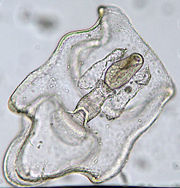
Bipinnaria
Encyclopedia
A bipinnaria is the first stage in the larva
l development of most starfish, and is usually followed by a brachiolaria
stage. Movement and feeding is accomplished by the bands of cilia. Starfish that brood their young generally lack a bipinnaria stage, with the eggs developing directly into miniature adults.
 The bipinnaria is free-living, swimming as part of the zooplankton
The bipinnaria is free-living, swimming as part of the zooplankton
. When it initially forms, the entire body is covered by cilia, but as it grows, these become confined to a narrow band forming a number of loops over the body surface. A pair of short, stubby arms soon develop on the body, with the ciliated bands extending into them.
In addition to propelling the larva through the water, the cilia also catch suspended food particles, and deliver them to the mouth (more correctly called a stomodeum).
Eventually, three additional arms develop at the front end of the larva; at this point it becomes a brachiolaria. In some species, including the common starfish Asterias
, the bipinnaria develops directly into an adult.
Larva
A larva is a distinct juvenile form many animals undergo before metamorphosis into adults. Animals with indirect development such as insects, amphibians, or cnidarians typically have a larval phase of their life cycle...
l development of most starfish, and is usually followed by a brachiolaria
Brachiolaria
A brachiolaria is the second stage of larval development in many sea stars; it follows the bipinnaria. Brachiolaria have bilateral symmetry, unlike the adult sea stars, which have a pentaradial symmetry...
stage. Movement and feeding is accomplished by the bands of cilia. Starfish that brood their young generally lack a bipinnaria stage, with the eggs developing directly into miniature adults.

Zooplankton
Zooplankton are heterotrophic plankton. Plankton are organisms drifting in oceans, seas, and bodies of fresh water. The word "zooplankton" is derived from the Greek zoon , meaning "animal", and , meaning "wanderer" or "drifter"...
. When it initially forms, the entire body is covered by cilia, but as it grows, these become confined to a narrow band forming a number of loops over the body surface. A pair of short, stubby arms soon develop on the body, with the ciliated bands extending into them.
In addition to propelling the larva through the water, the cilia also catch suspended food particles, and deliver them to the mouth (more correctly called a stomodeum).
Eventually, three additional arms develop at the front end of the larva; at this point it becomes a brachiolaria. In some species, including the common starfish Asterias
Asterias
Asterias is a genus of the Asteriidae family of sea stars. It includes several of the best-known species of sea stars, including the common starfish, Asterias rubens, and the northern Pacific seastar, Asterias amurensis.-Species:...
, the bipinnaria develops directly into an adult.

